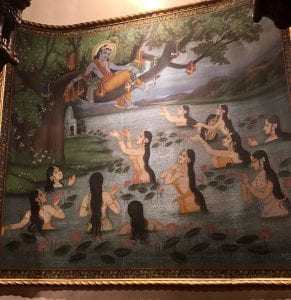I can’t say exactly what I expected when I entered the International Society for Krishna Consciousness temple in East Dallas, also called ISKCON, but the experience will certainly inform my idea of Hinduism as it was explained by our Vaishnavite Devotee guide.
It is true that no two Hindu experiences are the same. With such an enormous pantheon of gods and centuries upon which the holiest books were written and preserved, every region of the world practices a little differently. The understanding I took from the temple is rooted in a 20th-century movement, led by the still-beloved A.C. Bhaktivedanta Swami Prabhupada, more commonly called Prabhupada. It was he who founded the ISKCON temples in the United States, the first of which was established in New York in the 1960s. The spread of Prabhupad’s word was rapid over the following decade before he died, or as his followers will tell you, he left his physical form. There is, however, a very shiny life-sized physical statue of the Swami in Dallas’ ISKCON temple. Let it never be said he was forgotten (Cole, The Hare Krishna Movement).
Statues and imagery are plentiful in the temple, from the depictions of Krisha in all his blue androgynous glory to the various statues looking down on the temple floor. They aren’t imposing or intimidating by any means. In fact, despite the quiet of the temple, I found the atmosphere very open and welcoming. It felt positive, calm, and free from judgment.
There wasn’t a “correct” way to worship that I saw over the hour and a half visit. Everyone left their shoes in a storage room – a universally understood respect for cleanliness – but that was where the rules ended. Some devotees walked straight to the colorfully-garbed deities behind the gate to get face time for their visit. A few members opened the door and immediately laid their bodies out in a deep bow on the ground, stood, and moved to Prabhupad’s statue to repeat the motion. Every manner of dress, every level of physical ritual, every gender and age seemed to pass through, and all kept to themselves. They respected the individual prayer time of others, went about their business loving the gods, and left.
Our group was the loudest present, only because we spoke with our vibrant guide and each other. The tour was really more of a crash course in basic tenants of the ISKCON Hindu ideology. What stuck out to me most was the definition and place of a soul. Souls are without labels; they are not black, or Indian, or Republican, or belonging to a single physical form. The ideology of reincarnation and rebirth deems the soul eternal and the bodies temporary. This wasn’t reserved for man and woman either: the ideology extended to animals and gods, ready to change form at any moment. All things start and end, except a soul.


